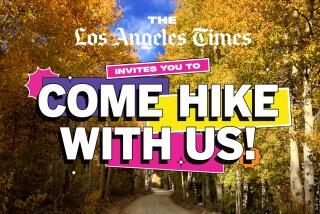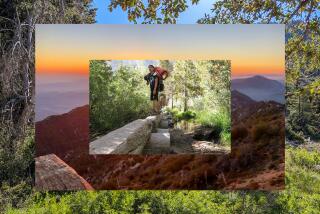Weekend Escape: Sequoia National Forest : With a full moon, an empty campground and a gourmet menu, roughing it was never smoother
SEQUOIA NATIONAL FOREST — My wife and I have often lamented that whenever we travel, someone invariably informs us that we should have been there last week, or last month or last year, because that’s when wherever we are was at its absolute best. If it weren’t for the fact that we always enjoy ourselves anyhow, we’d surely have boulder-size chips on our shoulders by now.
But a mid-June camping trip to Sequoia National Park cured us forever of this latent inferiority complex. For once, we were somewhere at the perfect time, and now I may just brag on into my afterlife.
Leslie and I left about noon Friday for the 4 1/2-hour drive to the steep granite mountains of the southern Sierra. From previous outings to Sequoia, we knew that we would bypass Lodgepole, the center of the Giant Forest area with a huge 260-site campground, a visitors center, stores, restaurants and hordes of people.
Those of us who like our weekend getaways devoid of mass crowding need go only a few miles farther north on the Generals Highway to find the same treasures of nature without all the hubbub. The campgrounds are smaller and quieter, with larger sites that provide more intimacy. We had stayed at Dorst campground, about eight miles northeast of Lodgepole, on our last visit to the park, and decided this time to go about five miles farther to Stony Creek, which sits in a small pocket of national forest land between Sequoia and Kings Canyon national parks.
Our first clue that this was going to be a special weekend came when we entered the Stony Creek campground. Although it was a warm 74 degrees, the deep winter snowpack had not fully melted at this elevation of 6,400 feet. Half of the campground was still buried under snow, but the other half, mostly the sites alongside the creek, were in perfect shape--dry, with clean fire pits and working water spigots. To our surprise, hardly anyone was there.
We didn’t reserve a site because we didn’t think we’d have trouble finding one, but we didn’t expect to get the pick of the litter. Yet that’s exactly what we got: our own forested plot of land alongside the sandy banks of the creek, which had so much water it gushed like a full-fledged river. The campground has 49 sites, and costs $8 a night. Stony Creek has clean bathrooms with flush toilets; however it does not have showers or electricity. The Stony Creek lodge half a mile down the road has public showers and laundry facilities. It also has a small market and restaurant.
After setting up our tent and unloading our supplies, Leslie and I took a late-afternoon hike along the creek. Although the calendar indicated that summer was fast approaching, the long winter had yet to fully withdraw from the Sierra, and in the air was that scent of renewal more commonly associated with early spring.
When we got back to our campsite, I started a fire while Leslie prepared the main course for that night’s menu. Camp cooking has become a hobby of ours and we had a couple of new recipes to test.
The first night would be salmon with lemon and herbs. Adapting a recipe from the Silver Palate Cookbook intended for chicken, she dressed two salmon filets in foil with dill, parsley, mint, garlic and lemon. After the fire provided enough coals, I threw the packets in for 15 minutes, turning them once. In the meantime, we cooked some long-grain brown rice on our double-burner propane camp stove and prepared a mixed green salad with a nonfat balsamic vinaigrette dressing.
It was delicious; the fish perfectly tender and moist. After we congratulated one another, we made a pot of coffee and divvied up our homemade chocolate chip cookies. During the course of the evening, we went from shorts and T-shirts to long pants and sweat shirts as the temperature dipped into the 40s. But the fire kept us warm, and the full moon provided an appropriate backdrop as we swapped vampire stories.
The next morning, after a breakfast of oatmeal, yogurt and fruit, we drove to the Redwood Mountain Grove, which is about six miles south of the Grant Grove area. Although the Giant Forest is the most well known of the park’s sequoia groves--after all, it does claim as a resident the General Sherman tree, which has the distinction of being the world’s largest living thing--the Redwood Grove is actually more extensive. But to see it, you have to hike to it; it is not accessible by car.
We took a leisurely seven-mile hike through the grove, which was mostly moderate with a series of gentle climbs and descents. Never have I seen so many sequoias at one time. The big trees attain incredible density along the picturesque canyon of Redwood Creek. They thin out at higher elevations, but even there were dense stands of sugar and lodgepole pine and red and white firs. And the fresh-smelling manzanita was everywhere. We stopped by the creek, which was flowing fast with the pale blue waters of just-melted snow, and ate our turkey pita sandwiches.
At a meadow where Leslie and I were going to play Frisbee, we came upon a young brown bear. From a distance of about 100 yards, he stared at us, and we respectfully returned the attention. After about five minutes we all went our ways.
Back at the campsite, we spent the late afternoon taking turns swinging in our hammock and throwing rocks into the creek. We had decided that we would eat late that evening, so we didn’t begin even marinating the chicken for the Indonesian satay until sundown.
The marinade had been prepared at home and stored in the cooler. It consisted of onion, garlic, pepper, lime juice, soy, molasses and canola oil. I cut up chicken filets for the skewer, as well as onion, red and green bell peppers and tomatoes. I threw a couple of potatoes in the fire (they take about 45 minutes) and two artichokes were cooking on the gas camp stove. I put a lightweight grill frame over the coals in the fire pit and cooked the satays for about 15 minutes. We sat down to eat about 10:15, figuring that if we were in Paris, we would still be eating hors d’oeuvres.
We slept in Sunday morning. Leslie had wanted a traditional outdoor breakfast, and I promised to make it for her. So we had fried eggs and bacon--only I used egg whites and turkey bacon. It was interesting, but not quite like the real thing. The deep snowpack on the mountain tops meant that the park’s lakes and rivers were awash in fresh runoff, and nowhere would that be better celebrated than at the Tokopah Falls in the Giant Forest area. We packed up the car and drove to the falls’ trail head in Lodgepole. Descending 1,000 feet along a stepped series of cascades into the Kaweah River, the falls are at the end of an easy 1.7-mile hike through a glacier-sculpted canyon. Looming above are 1,800-foot granite walls. A dense stand of pine forest gives way to a classic High Sierra vista: a treeless terrain of silver-hued boulders against the roar of a raging waterfall.
We sat at the base of the falls and nibbled on leftover satay, listening to the rhythmic echo of the water pounding endlessly against the rocks. It was simply the perfect time to be here.
(BEGIN TEXT OF INFOBOX / INFOGRAPHIC)
Budget for Two
Gas from Los Angeles: $29.50
Campsite, two nights: 16.00
Food and supplies: 102.60
Firewood: 16.00
Park entrance fee: 5.00
FINAL TAB: $169.10
National Forest reservations (Stony Creek campground), tel. (800) 280-2267. Sequoia and Kings Canyon national parks, tel. (209) 565-3351.
More to Read
Sign up for The Wild
We’ll help you find the best places to hike, bike and run, as well as the perfect silent spots for meditation and yoga.
You may occasionally receive promotional content from the Los Angeles Times.






